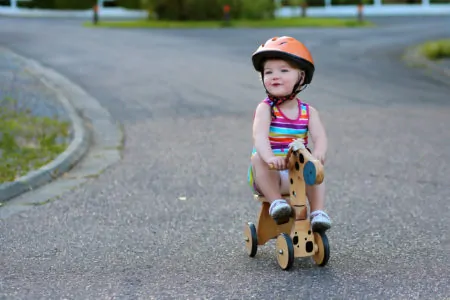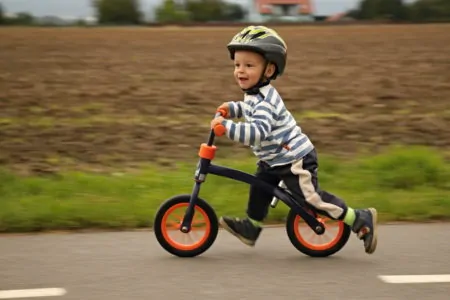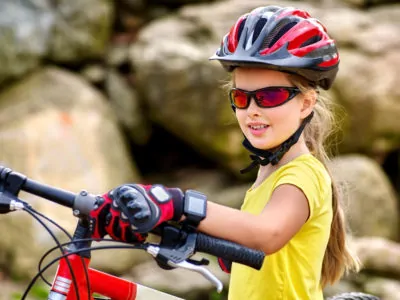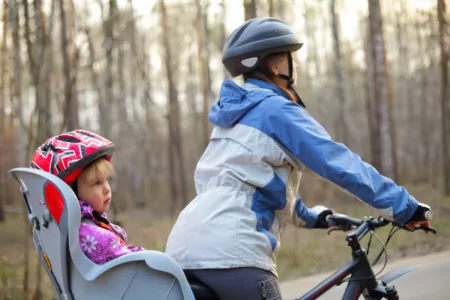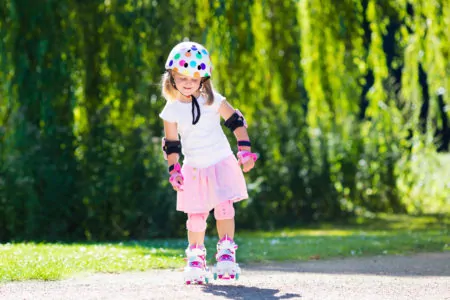Hoverboards look like they came straight from the future. They are sleek, exciting, and fun. But as you watch your child beg for one, a big question pops up. “What age is appropriate for a hoverboard?”
Most manufacturers recommend riders be at least eight years old. However, the American Academy of Pediatrics (AAP) suggests kids can ride them starting at six (source). It is confusing to know who to listen to.
Your child’s safety is the priority. I will walk you through age requirements, safety precautions, and how these devices work. I will also help you find the best hoverboards for your child’s specific age group.
Key Takeaways
Hoverboards are not advised for children under 5. The American Academy of Pediatrics says children over six can ride one, but most manufacturers recommend their products for ages 8+. Hoverboards require coordination, balance, and core strength. Following the manufacturer’s age guidance helps minimize the risk of injury.
What Age Is Appropriate for a Hoverboard?
The AAP suggests hoverboards and skateboards are unsafe for children 5 years old and under. They state that children over the age of six can ride a hoverboard with close adult supervision. However, you will notice that most hoverboard manuals set the minimum age at 8 years old.
Hoverboards require significant coordination, balance, and core strength. Children under eight are still developing these motor skills. This puts them at a higher risk of falling and getting hurt.
There is also a maturity factor. Riding a hoverboard requires common sense and quick decision-making. You must follow local rules, avoid busy streets, and wear safety gear every time.
Most eight-year-olds can understand these risks and follow instructions. Younger kids might not fully grasp the dangers of moving vehicles.
How a Hoverboard Works
A hoverboard is a self-balancing electric scooter. It uses internal gyroscopes and sensors to detect your movements. It has two platforms (one for each foot) and two wheels.
Think of it as a Segway without the handlebars. Unlike a skateboard where you stand sideways, you face forward on a hoverboard.
The movement relies on your body weight:
- Moving forward: Lean your toes forward slightly.
- Moving backward: Lean back on your heels.
- Turning: Push one foot forward while keeping the other neutral or pulling it back slightly.
Are Hoverboards Safe for Kids?
Hoverboards carry risks for both kids and adults. However, if you buy a quality board and enforce safety gear rules, they are comparable to riding a bike or skateboard. The key is preparation.
You should always use helmets, knee and elbow pads, and wrist guards.
Here is what you need to know about the risks:
- Falls and Collisions: Between 2017 and 2021, there were 77,200 injuries related to micromobility vehicles (1). The most common injuries for kids are fractures, sprains, and bruises.
- Fire Hazards: You may remember news stories about exploding hoverboards. Since 2017, safety standards have improved drastically thanks to UL 2272 certification. This testing minimizes fire risks. However, battery safety is still important. In 2022, there were 11 deaths linked to micromobility fires (2).
You can reduce these risks significantly. Buy UL-certified boards, supervise young riders, and never leave the device charging unattended.
How To Choose an Age-Appropriate Hoverboard
Picking the right board makes a huge difference in safety and fun. Here are the specific features to look for.
Speed Range
Hoverboards generally top out between 6 and 10 miles per hour (mph). For children and beginners, stick to boards with a max speed of 6 or 7 mph. Speeds over 10 mph increase the severity of falls and should be reserved for experienced teens or adults.
Portability and Weight
Your child will eventually have to carry the board when the battery dies or the terrain gets rough. Most boards weigh between 20 and 30 pounds. This is heavy for a young child.
Look for lighter models if you anticipate a lot of carrying. You also need a dedicated spot to store it.
Safety Tip
Do not charge your hoverboard in a closet or small enclosed space. Charge it in a well-ventilated area to keep the battery cool.
Wheel Size
Wheel size dictates where you can ride.
- 6.5-inch wheels: These are standard. They are best for smooth pavement and indoor use. They are lower to the ground, making them easier for kids to mount.
- 8.5 to 10-inch wheels: These are for “all-terrain” riding. They handle grass and gravel better but sit higher off the ground. These are better suited for taller kids and teens.
Minimum Weight Requirement
This is a detail many parents miss. Hoverboards have a minimum weight requirement, usually around 44 pounds (20 kg).
If your child is too light, they will not engage the sensors correctly. The board might shake violently or stop suddenly. Always check the minimum weight before buying for a younger child.
Safety Features
Never compromise on these safety essentials:
- UL 2272 Certification: This is mandatory. It ensures the electrical system and battery have passed rigorous safety tests.
- Non-slip foot pads: These provide grip and keep your child steady.
- Beginner Mode: Many boards have a “training mode” that limits speed and sensitivity while your child learns.
- Battery Type: Look for quality lithium-ion packs with safety shields, or LiFePo batteries which are less prone to overheating.
Best Hoverboards for Different Age Groups
I have categorized the top picks by age group to help you make a quick, informed decision. Whether you have a cautious 6-year-old or a thrill-seeking teen, here is what fits.
For Young Children (Under 6)
The AAP and most manufacturers agree: hoverboards are not for kids under 6. They generally lack the weight to trigger the sensors and the coordination to steer safely.
If your little one wants wheels, try these safer alternatives:
- Beleev A2 Scooter: A stable, manual scooter that builds balance.
- Strider Balance Bike: Perfect for learning two-wheeled coordination without the speed.
For Children (6 to 12)
While AAP says 6+ is okay, always check the specific board’s manual (usually 8+). For this age group, you want moderate speeds and vibrant lights.
Here are three solid choices:
- Wilibl Hoverboard for Kids: This board is UL 2272 certified and designed for ages 6 to 12. It features a self-balancing system that automatically levels the deck when powered on. This makes it incredibly easy for beginners to step on without wobbling.
- Felimoda Hoverboard: This is a great budget-friendly option. It tops out at 6 mph, which is plenty fast for a driveway but slow enough for parents to jog alongside. The Bluetooth speaker is a huge hit with kids who want to listen to music while riding.
- Hover-1 Drive Electric Hoverboard: This is a reliable entry-level board for kids 8 and up. It reaches 7 mph and runs for about 3 miles per charge. That short range is actually a benefit; it ensures your kids stay close to home.
For Teens
Teens need higher weight limits and a bit more speed. However, you still want UL safety certification.
Consider these options:
- Razor Hovertrax Prizma: Razor is a trusted brand in this space. This board hits 9 mph, offering a thrill for experienced riders. The “Prisma” light show is cool, but the real selling point is the EverBalance technology that makes the ride super smooth.
- Gotrax Glide Pro: If your teen is a first-time rider, start here. It has a sensible 6.5 mph speed limit and sits low to the ground. It is stylish enough for teens but safe enough for beginners.
For Adults
If you are over 18, you are likely looking for power and range. Adult boards handle heavier weights and rougher terrain.
- EPIKGO Hover Self-Balance Board: This is the SUV of hoverboards. It holds up to 265 pounds and climbs 18-degree slopes. The large tires allow you to ride over dirt and grass, making it a genuine transport tool rather than just a toy.
- Gyroor All Terrain Hoverboard: This board is built for off-road fun. It features rugged 8.5-inch tires and strong motors. The app control is a great feature; it lets you adjust speed limits, making it versatile if you plan to share the board with your kids.
For Seniors
Seniors can absolutely ride hoverboards if they have good balance. The key is finding a stable, easy-to-mount board with a predictable speed.
- Swagtron Swagboard Twist: This is a simple, no-fuss board. It uses a LiFePo battery (safest chemistry available) and has standard 6-inch wheels. It is lightweight and easy to control, perfect for cruising on flat pavement.
- Hover-1 Dream Electric Hoverboard: This board grows with your skill level. You can toggle riding modes to increase sensitivity as you get comfortable. It handles a decent 220-pound weight limit and 10-degree inclines.
Hoverboard Laws and Restrictions
Before you head out, check your local laws. In general, riding on private property is legal. Public spaces are where it gets tricky.
Here is a breakdown of hoverboard laws by state (3).
| State | Laws and Regulations |
| Alabama | Allowed on public highways, sidewalks, and cycle paths; users must give way to pedestrians and manual vehicles (i.e. bikes) and audibly signal before passing pedestrians. |
| Alaska | Maximum speeds of 15 mph; check local laws before riding in specific areas. |
| Arizona | Varies by municipality; some areas have banned hoverboards from public areas. |
| Arkansas | No specific laws. |
| California | Hoverboards are banned from highways, cycle paths, sidewalks, and trails; users must wear safety equipment; 20 mph limit; local authorities may have their own rules. |
| Colorado | Hoverboards are only allowed on sidewalks. |
| Connecticut | It’s not set in stone, but riders should be at least 16 years old, and the hoverboard must have front, back, and side reflectors and lighting. |
| Delaware | Maximum speeds of 15 mph; allowed on sidewalks and cycle lanes with a maximum speed of 8 mph and other restrictions; user must wear a helmet and be at least 16 years old; hoverboard must have front, back, and side reflectors and lighting. |
| Florida | Allowed on streets with a 25 mph speed limit; allowed on cycle lanes, at intersections, and on sidewalks; riders under 16 must wear a helmet. |
| Georgia | No state-specific laws; check local city guidelines before riding away from private property. |
| Hawaii | Allowed on sidewalks and cycle lanes up to 8 mph; you can only use hoverboards that have a maximum setting of 8 mph; riders must be at least 16 years old; hoverboard must have reflectors, and riders must wear a headlamp from dusk to dawn. |
| Idaho | Allowed on sidewalks, but this varies depending on the political subdivision in charge of sidewalks. |
| Illinois | Hoverboards are banned from many campus buildings and trains operated by Metra. No other specific laws, but highly frowned upon when used on roadways and sidewalks in business districts. |
| Indiana | Legal if the motor is under 750w and speeds under 20 mph; banned in many schools and universities. |
| Iowa | User must be at least 16 to ride on sidewalks and bike paths; rider must give right of way to pedestrians and manual vehicles (i.e. bikes); riders must give audible signal when overtaking a pedestrian; banned at night unless the rider or hoverboard has a headlight at the front and a red reflector on the back. |
| Kansas | Hoverboards can follow the same road rules as motor vehicles. |
| Kentucky | No specific laws; check local regulations; users must be 16 or older and wear a helmet. |
| Louisiana | Allowed on sidewalks, cycle paths, and roads with 25 mph max speed limit; may vary by local authority; don’t go faster than 20 mph. |
| Maine | Allowed on sidewalks and public roads with 35 mph speed limits, unless banned by local ordinance or law; rider must wear reflective clothing and have reflective devices between dusk and dawn; maximum 5 mph on sidewalks and 15 mph on public roads and cycle paths. |
| Maryland | Banned from roadways with a 30 mph speed limit or over; same rights as pedestrians in places other than intersections; maximum speed limit of 15 mph. |
| Massachusetts | Allowed on all public ways, including cycle paths, sidewalks, and roadways under 35 mph; banned from limited access and express state highways; subject to 5 mph on sidewalks within business districts; riders must not use on sidewalks at a speed that may cause danger; they must give way to pedestrians and service animals; riders must utilize lights at night time. |
| Michigan | Hoverboards must ride to the right side of a roadway; cannot ride more than two abreast on a roadway, except on designated paths; no passing between traffic lanes; must give way to pedestrians; banned from sidewalks designated for pedestrians; maximum speeds of 25 mph. |
| Minnesota | Same rights as a pedestrian; suitable for cycle paths; cannot be used at an unreasonable speed on roads, sidewalks, and cycle lanes; banned from roads with speeds limits over 35 mph; hoverboards must have reflectors on front, back, and wheels that are visible from 600 feet away. |
| Mississippi | Allowed on marked cycle paths, roads where bicycles are allowed, and sidewalks as long as the rider gives way to pedestrians. |
| Missouri | Allowed on streets, highways, sidewalks, and cycle paths under 45 mph speed limits; riders have the same rights as a pedestrian; you must be 16 or older to use a hoverboard; may change from city to city. |
| Montana | Allowed on sidewalks, cycle lanes, and roads with 35 mph speed limits or less; not allowed on sidewalks subject to traffic control devices that limit Electric Personal Assistive Mobility Devices (EPAMDs). |
| Nebraska | Allowed on streets, sidewalks, and cycle lanes up to 20 mph; may vary depending on the municipality; rider must use headlights and reflectors at night. |
| Nevada | Each city has different regulations. |
| New Hampshire | Riders have the same rights as pedestrians; the rider must stay on the right side of the road as much as possible. |
| New Jersey | Allowed on public highways, sidewalks, and cycle lanes; riders have the same rights as cyclists; may vary depending on the municipalities; riders must wear helmets and be at least 16 years old. |
| New Mexico | Hoverboard must have front, back, and side reflectors, a braking system, and a white light for night times; the rider has the same rights as a pedestrian and must give way to pedestrians. |
| New York | Allowed on sidewalks outside of New York City; in New York City, it is illegal to ride hoverboards on the streets or sidewalks. |
| North Carolina | Allowed on sidewalks, cycle paths and roads with a 25 mph maximum speed limit; there is no helmet requirement or age limit; riders must give way to pedestrians; this may change depending on the municipalities. |
| North Dakota | Banned from cycle lanes and sidewalks; must be used with taillights and headlights; riders under 18 must wear helmets. |
| Ohio | Allowed on public streets, highways, cycle lanes, and sidewalks under 55 mph speed limits; riders must be at least 18 and wear helmets; if between ages 16 and 18, they must be supervised by an adult; must give way to pedestrians; proper lighting and reflectors required at night time; children under 14 are banned from riding hoverboards at all. |
| Oklahoma | Banned from highways and turnpikes; allowed on walking trails, bike paths, municipal streets, and sidewalks; this may vary depending on the city. Riders must obey speed limits and yield to pedestrians. |
| Oregon | Riders have the same rights and responsibilities as cyclists when riding in a cycle lane, path, or highway; when riding on a sidewalk, riders have the same rights as pedestrians. |
| Pennsylvania | Allowed on sidewalks and roads; this may vary by local regulations; banned from freeways. |
| Rhode Island | Riders are subject to all traffic laws applicable to any vehicle; hoverboards are allowed on highway shoulders, except highways that prohibit cyclists; riders have the same rights as pedestrians; this may vary from city to city. |
| South Carolina | Allowed on roads, cycle routes, paths, trails, and sidewalks; user must audibly signal before overtaking a pedestrian; 15 mph maximum speeds; local authorities can make their own rules; if a sidewalk is available, the rider must use that instead of a road or highway; banned from freeway main facilities with exceptions; hoverboard must be equipped with a stopping mechanism and a bell or other audible tool (excluding sirens and whistles). |
| South Dakota | Maximum 15 mph ability; banned from sidewalks. |
| Tennessee | Allowed on public highways, bike trails and paths, and sidewalks unless stated by local laws; must follow speed limits; must yield to pedestrians. |
| Texas | Allowed on residential streets, roads, and highways with a speed limit of 30 mph or less. |
| Utah | Subject to the same rules as bikes, mopeds, and motor-driven bikes; riders must be 15 or older unless supervised by a parent or guardian; banned with highways with more than four lanes or speed limits higher than 35 mph’ riders must have a front lamp visible up to 300 feet and front, back and side reflectors for riding at night. |
| Vermont | Must have front, back, and side reflectors and a controlled stopping system; hoverboard must have a white front light from dusk to dawn; riders have the same rights as pedestrians; this may vary from city to city. |
| Virginia | Maximum speeds of 20 mph; children under 14 must have adult supervision; suitable for roads with a speed limit of 25 mph or less; allowed on crosswalks; banned from any Interstate Highways System component. |
| Washington | Banned from fully controlled limited access highways; allowed on sidewalks or crosswalks; riders have similar access and parking rights as bikes; banned from nonmotorized trails with natural surfaces; riders must yield to pedestrians; different cities have the rights to their own laws. |
| West Virginia | Hoverboards must have front, back and side reflectors, a braking system and a white light for nights; riders have the same rights as pedestrians. |
| Wisconsin | Riders must use them close to the right edge or curb of a road; on one-way highways with two or more lanes, they must be near the left curb; banned from some roads (with signs); riders must yield to pedestrians; allowed on sidewalks unless prohibited by specific rules. |
| Wyoming | Banned from public roads; 20 mph speed limit overall; allowed on sidewalks and pedestrian paths. |
Safety Tips for Hoverboards
Risks exist, but smart habits prevent accidents. Here are five essential tips for safe riding:
- Verify the UL Certification: Look for the holographic UL 2272 seal on the bottom of the board. This confirms it passed electrical fire safety tests.
- Stick to Safe Zones: Avoid crowded sidewalks and nighttime riding. Even with lights, hoverboards are low to the ground and hard for cars to see.
- Gear Up Every Time: A skateboard helmet is non-negotiable. Wrist guards are also crucial since the natural reaction to a fall is to put your hands out.
- Scan the Terrain: Smooth, flat pavement is your friend. Cracks, bumps, and gravel are the enemies of small hoverboard wheels and can cause immediate falls.
- Charge Responsibly: Use a wall outlet in an open area. Do not charge overnight while you sleep. Keep a fire extinguisher in the house as a general safety precaution.







